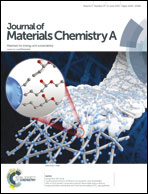A cost-effective, stable, magnetically recyclable photocatalyst of ultra-high organic pollutant degradation efficiency: SnFe2O4 nanocrystals from a carrier solvent assisted interfacial reaction process†
Abstract
A cost-effective, stable, magnetically recyclable photocatalyst of ultra-high organic pollutant degradation efficiency, SnFe2O4 nanocrystal (NC), was developed. SnFe2O4 NCs were produced with a simple, fast, room temperature, surfactant-free, co-fed precursor, carrier solvent-assisted interfacial reaction process. The outstanding organic pollutant degradation efficiency of the SnFe2O4 NCs was demonstrated with rhodamine B (RhB) degradation in a Fenton-like process under illumination of simulated sun light at 100 mW cm−2. The apparent reaction rate constant can reach as high as 0.35 min−1, one order of magnitude higher than 0.02 min−1 achieved by commercial P25 powders. The excellent magnetic recyclability and cycling stability of SnFe2O4 NCs toward RhB degradation were also demonstrated. A degradation mechanism is proposed to show how chemical and photochemical catalyzations work to realize the ultrahigh degradation efficiency of the SnFe2O4 NCs. The SnFe2O4 NCs prove to be a highly efficient and promising catalyst for Fenton-like processes for removal of recalcitrant organic pollutants.


 Please wait while we load your content...
Please wait while we load your content...